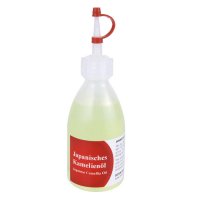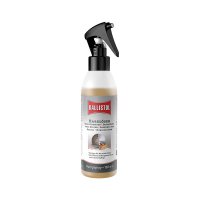
For high-quality tools to remain ready for use over a long period of time, you need to take appropriate care of them and store them properly. It is common knowledge that tools should be cleaned after use. This is a matter of course for knives - after all, they come into contact with (perishable) food. But you should also clean your axe, plane, saw or garden shears after use and maintain them regularly. After cleaning, you can examine your tool to see if any damage needs to be repaired and, if necessary, sharpen your old friend for the next use. Oil is an important component, especially for tool care. If possible, use only vegetable oils such as Japanese camellia oil or Sinensis camellia oil. Similarly, Ballistol, which is based on medically pure white oil, is a good vegetable oil. Unlike mineral oils, vegetable oils are biodegradable and thus safe to use.
Knives
Knives are among those tools that, on the one hand, get dirty every time they are used, but on the other are among the cleanest tools – dried-on food residue is not nice on any knife, after all! After cleaning and care, you can then decide whether you also need or want to sharpen your knife.
How do you clean a knife?
A good knife does not belong in the dishwasher – that has become common knowledge. You should only clean the knife by rinsing it with lukewarm water and a little washing-up liquid. A soft sponge scourer can be used for this purpose. Dry the knife well afterwards. This applies to all high-quality knives – not just Japanese knives!

If knives are not cleaned immediately after use, some food residue may dry on. In our experience, these are easy to remove with the Japanese Kamenoko Tawashi brush – which, unlike sponges, does not get caught on the end of the blade. Important: never use abrasive cleaners or similar.
Tip: When working with acidic foods (lemons, apples, etc.), always clean the knife immediately.
How do you maintain a knife?
Knives that are not rustproof should not only be cleaned and dried quickly, they also could do with a little camellia oil. Rust on a high-quality knife is never good. For storage, you should not simply throw all your high-quality knives into a drawer together. It is better to use a knife block or a knife bench. The blades do not damage each other and at the same time the risk of injury when removing a knife is reduced.
More tips on handling and caring for Japanese knives

If you want to remove a slight rust film from your knife, we recommend a coarse rust eraser, and an abrasive fleece such as the Klingspor abrasive fleece (fine). If there is rust on the cutting edge, it will disappear during sharpening.
Axes & hatchets
Few craftsmen use their outdoor axes very often. Normally, they are only used seasonally and afterwards wait in the workshop until their next use. So it is crucial that you always clean axes and hatchets after use.
How do I clean an axe?
It is easier to remove soil residue if it has already dried a little. You can brush it off easily in most cases – the Kamenoko Tawashi also help here. For more stubborn residue, you can resort to a damp cloth. Make sure that you do not wet the handle too much when doing this. Dampness is exactly what should be avoided with a wooden handle. It could cause it to swell and lose cell strength.
If there is any resin residue, a resin solvent such as Ballistol Resin Solvent will help. Simply spray it on and wipe it off again together with the dissolved resin. Then neutralise the resin solvent by applying a little camellia oil.
On outdoor adventures especially, there is often no cleaning kit available at the end of the day. A good temporary solution is to use tall grass or a similar natural material (immediately after use), to wipe off any shavings, grass or even clumps of soil that have stuck on.
How do you maintain an axe?
A thin film of oil, for example camellia oil, protects rarely used axes and hatchets. With axes made of carbon steel, you should always apply a thin film of oil as corrosion protection. Protect the cutting edge with the supplied protective sheath and store the axe in a dry place. The place should be dry enough so that the wooden handle doesn’t swell, but damp enough so that it does not dry out too much and possibly become loose and fall out of the axe later.
How do you sharpen an axe?
Handy sharpeners, such as the foldable DMT Diafold all-purpose sharpener, are particularly helpful when on the move. The foldable handle also serves as a protective sleeve for the diamond plate. Just as handy and equipped with integrated storage solution is the Gränsfors diamond sharpening file for axes. It comes with a leather sheath so that the file does not get damaged in the backpack during outdoor adventures. Also ideal for on the go is the Gränsfors Synthetic Sharpening Stone for Axes, supplied in a in rubber case. It features one side with a coarse 180 grit for pre-sharpening and a fine 600 grit side for honing.

If you use and sharpen your axes and hatchets regularly, you can use grinding machines such as the Tormek.
Saws
Provided you use your saw exclusively in a (dry) workshop, maintaining it is relatively easy. With saws that also come into contact with freshly cut wood, trees or shrubs, the potential for contamination is significantly higher.
How do I clean a saw?
The same best practice applies to saws: they should also be cleaned after each use. Remove the wood residue or wood dust from the saw. To do this, use a simple dry cloth and wipe from the saw back towards the cutting edge. Important: Never touch the cutting edge of the saw. High-quality saws are often made of carbon steel and are therefore not protected against corrosion, so clean these carefully.
You may find that resin causes wider saw blades to stick in the saw cut or to saw very sluggishly. If so, a little paraffin wax on the saw blade makes the saw glide smoothly again.
If you use your saw in the garden or even on a long trip, the saw can not only get damp but also really dirty. Since these saws are usually rustproof, this is not a big deal. You should wipe off coarse dirt immediately – again, tufts of grass or leaves help here. After this rough cleaning, you can clean the saw properly back in the workshop/at home. A Japanese saw and file brush is ideal for this purpose. Simply remove resin with resin solvent, such as the Ballistol resin solvent already mentioned.
How do you maintain a saw?
Regularly treat saws made of carbon steel with a little oil, for example camellia oil. And even though outdoor saws do not rust – they fare better with a little oil, folding saws as well, at the joint. If the saw has a tooth protection, you should always put it on to protect the saw blade – and your hands reaching into the drawer.
How do you sharpen a saw?
Blunt saws not only require more force, but the cutting pattern changes and irregular movements also increase the risk of injury.
Keep in mind that not all saws can be sharpened; e.g. Japanese saws with hardened tooth tips or cheap saw blades for frame saws made of soft steel. Our saw vicesaw vice is particularly helpful, allowing you to resharpen back saws precisely and vibration-free.
Planes
Wooden planes can be quite demanding hand tools in terms of maintenance and care, depending on the design. Just sharpening the plane blade doesn’t cut it.
How do I clean a plane?
In everyday use, just remove wood dust and chips from your plane. Wood dust is quickly wiped off with a dry cloth. If too many chips have collected in the plane mouth, you may have to take the plane apart.
How do I maintain and sharpen a plane?
Unlike metal planes, wooden planes can warp easily and the wear on the plane sole is significantly greater. Therefore, you should check the plane sole regularly and true it if necessary. Sharpening the blade rounds off plane care.
In this post we have summarised what you need to bear in mind when maintaining and caring for wooden planes.

Scissors and shears
When used as intended, your scissors should not actually need much cleaning – except for garden shears. However, as scissors are often not used for their intended purpose, you should be prepared just in case.
How do I clean and maintain scissors?
If you have ever, for example, tried to cut through adhesive tape with a pair of scissors and now have adhesive residue stuck to the scissors, it is important to get both scissor blades clean and functional again. If you can disassemble the scissors, like our multifunctional scissors, take them apart. Now you can try to remove as much adhesive residue as possible with another piece of tape. To do this, stick a strip of the »new« adhesive tape over the adhesive residue and then quickly tear it off. This also works with most scissors that cannot be disassembled. Stubborn adhesive residues can be tackled with orange oil. Orange oil is excellent for removing adhesive residue, labels, etc. For easy dosage, you can transfer the orange oil into a small spray bottle. Apply the orange oil to a fine cloth and rub it over the remaining adhesive residue until it comes off.
When you have cleaned your scissors without orange oil, you should apply some camellia oil to finish. If you’re cleaning paper scissors, don’t apply oil, or it will leave unsightly stains on your paper.
How do I clean and maintain garden shears?
Garden shears should first be cleaned of coarse dirt. For this purpose, you can use for example, the Kamenoko Tawashi Japanese brush . Then clean your garden shears with a sponge, water and soap. If there is still resin residue or similar on the garden shears, you can use the Barnel® »B Clean« cleaning spray, which has been specially developed for this purpose. With this spray you can remove resin residue in no time. Neutralise the cleaner with a little oil afterwards

Garden Tools
Regular cleaning and maintenance also pays off for your other garden tools.
How do I clean garden tools?
Choose the cleaning agents according to the material and its wear-resistance. First remove the coarse dirt. With a stainless steel spade, you can certainly use a stainless steel wire brush. For more sensitive surfaces, it is better to use a sponge.
Once the coarse dirt has been loosened, tackle the remaining dirt with a sponge, warm water and a little soap and clean your garden tools thoroughly.
How do I maintain garden tools?
When maintaining garden tools, the following applies: Wooden handles should be oiled at least once a year, and metal surfaces also appreciate some oil as corrosion protection. Use vegetable oil, for example, camellia oil. Joints should be well lubricated; universal multi-purpose grease is suitable for this purpose.










